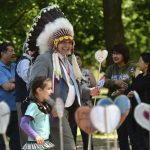Still looking for truth
Residential schools report, First Nations leaders mislead on problems plaguing reserves
The residential school story is now well-known to Canadians. It is accepted wisdom that residential schools were created to strip aboriginal children of their culture. Some of the children who attended the schools were often physically and sexually abused by their teachers, and returned to their communities as broken people, resulting in the alcohol abuse, domestic violence and general social breakdown that plague so many aboriginal communities today.
This is the story, but the issue is the numbers. Using the figures from the report on the Truth and Reconciliation Commission (TRC) a total of 150,000 children attended the schools from 1800 to 1970. Although more children attended in some years than in others, this is an average of less than 1,000 per year. That is a small number in relation to the aboriginal population.
The question then becomes how many of this small percentage of children suffered physical and sexual abuse at the hands of those in charge? While one is too many, it’s clear that not all children were treated poorly. In fact, some have spoken about the fact that residential schools provided them with an education.
It needs to be made clear that children were not receiving a meaningful education on the reserves. The government was not involved with such matters in the early years, and left any attempts at education to the churches. The main business of the churches was religious instruction, but even in cases where a priest or mission pastor had some competence in teaching and felt a responsibility to teach, the results were poor. Historical accounts from clergy on reserves talk about schools emptying out when the caribou came, or when the fish were running. Sitting in a school room was alien to aboriginal culture.
The mission school model was a failure. Aboriginal children were receiving either a very poor education, or no education at all. The people who saw the need to correct this by establishing Indian Residential Schools were from a different age, with attitudes very different from our own. They spoke of “civilizing the Indians,’ and used other pejorative terms that are completely unacceptable today. But those were the beliefs of the time. The true racists didn’t care about aboriginal education. They were happy to see aboriginal people languishing on reserves.
And languishing they were. The hopelessness and dependence that characterizes life on so many reserves had already set in. Not only did the great majority of aboriginal children who did not attend residential schools receive little or no education, an astounding number did not even make it to adulthood. If an aboriginal child survived birth, he or she had a one in four chance of dying from tuberculosis alone. Other diseases hit reserve residents particularly hard, and most of the children who survived lived and died in poverty. It was clear that education was the only way out.
No doubt, in some cases there were undoubtedly people who were so traumatized by their abuse that the resulting dysfunction within their families has lasted for generations. However, for many, that dysfunction was already there. Just look at the vast areas of Canada that had no residential schools at all — entire provinces. The social dysfunction on reserves was and is no different from that which exists in areas where the schools operated.
None of this excuses the harsh treatment or sexual abuse of children who were victimized, or the bigotry of the time. The legitimate surviving victims deserve every bit of compensation awarded to them. Residential schools were a dismal failure. But there seems to be some exaggeration on the numbers and the survivors are being used for a political agenda.
That may be because the residential school system is what most of the First Nations political leaders experienced and thus this is their reality. But the question is: Is it the reality of most First Nations and is the response from these leaders based on their lived experience, limiting alternative perspectives?
If you look closely at the TRC report you will see that the most significant recommendations are basically a repeat of those from the Royal Commission on Aboriginal Peoples in 1996. That backward-looking document demanded the continuation and expansion of the same racial separateness scheme that served as a model for the creation of apartheid South Africa’s “homelands’ system — the same racial separateness scheme that keeps most of Canada’s aboriginal people poor and dependent. Yet, that separateness seems to now be what’s being advocated for by aboriginal political leaders.
That’s not reconciliation.
Brian Giesbrecht (Winnipeg Free Press) was a provincial court judge from 1976 until 2007. He is now retired.
Photo credit: Sean Kilpatrick / The Canadian Press – Assembly of First Nations National Chief Perry Bellegarde in the heart garden at the closing ceremony of the TRC in Ottawa in 2015.








